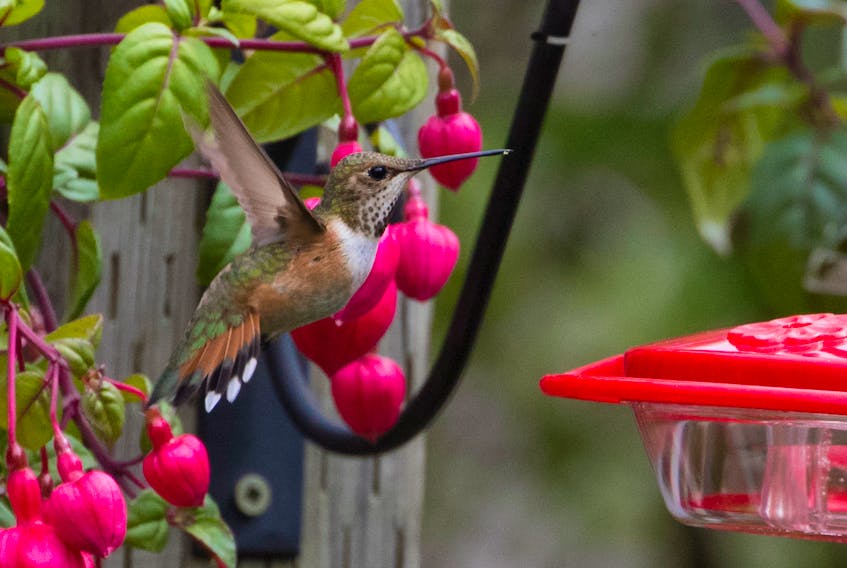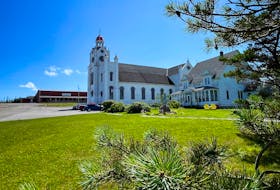Hummingbirds are present in low numbers on the island of Newfoundland mainly during the summer months.
Ruby-throated hummingbird is the only species of hummingbird breeding in eastern North America. In Canada,

it is quite common from Alberta to Nova Scotia.
Hummingbirds all but stop at the Cabot Strait with only a few crossing to the island of Newfoundland. Ruby-throated hummingbirds have been nesting in the southwest corner of Newfoundland, especially in the Codroy Valley for decades.
The rest of Newfoundland gets visits from roaming ruby-throated hummingbirds during the spring and summer.
They never seem to linger longer than a few days.
They are attracted to colourful flower beds or a hummingbird feeder. Hummingbird feeders can be found for sale in the larger hardware stores.
It is important to use the proper ratio of sugar to water mix in the feeder.
This ratio and other tips on feeding hummingbirds are easily found on the internet.
There is a whole society of hummingbird feeder watchers out there. You can learn about them at this web site http://hummingbirdscanada.ca/.
Putting up a hummingbird feeder is a long shot in Newfoundland. It helps to have plenty of colourful flowers in your garden but there is no guarantee you will ever get one to visit.
Clara Dunne of Renews undaunted by the odds hung a hummingbird feeder in her garden in June 2014. Without warning a ruby-throated hummingbird showed up a few days later. The elation lasted only a day as the bird moved on but it was a start.
From then on Clara has had sporadic visits from ruby-throated hummingbirds every summer up to this one. They stayed a day or two, or sometimes a week. There was never any suggestion that they were staying around to nest.
In Canada, it is quite common from Alberta to Nova Scotia. Hummingbirds all but stop at the Cabot Strait with only a few crossing to the island of Newfoundland. Ruby-throated hummingbirds have been nesting in the southwest corner of Newfoundland, especially in the Codroy Valley for decades. The rest of Newfoundland gets visits from roaming ruby-throated hummingbirds during the spring and summer.
On the evening of June 27 this year Clara was again elated to see a hummingbird at her feeder. The trail cam camera positioned on a tree and aimed at the hummingbird feeder captured an image of the little bird. It was a blurry image, but to Clara it did not look right for a ruby-throated hummingbird.
Early the next morning she was in the garden with her proper camera and secured some better images. Her initial reactions were well founded. The bird showed a distinct rusty brown colour on the sides and in the tail. She looked it up in her book and identified it as a possible female rufous hummingbird.
Clara then texted me the pictures for an opinion. It was indeed the very rare rufous hummingbird originating from the mountains of western North America in British Columbia south to California.
Ken Knowles, John Wells and I were birding in the fog at St Vincent’s beach waiting in vain for the fog to lift when Clara’s pictures came through. It was a no brainer to make a change of plans and bee line it to Renews.
Within a few minutes of arriving, the hummer appeared at the feeder showing us exactly what we wanted to see on a for real rufous hummingbird. It was the strong buffy brown colour along the sides of the body and the deep orange-brown at the base of tail feather that did it. The ruby-throated hummingbird is green in these areas.
Why a rufous hummingbird flies thousands of kilometres east of its normal range is unknown but it has happened three time previously in Newfoundland. All records were from August in the years 1985, 1988 and 2011. All in all an exciting visitor to your garden.
BABY BIRDS
Baby birds are fledgling everywhere right now. Short-tailed robins with black-spotted breasts are a common backyard sight. The squawking of young fawn-coloured starlings following around their black parents is common on residential lawns and urban areas. It is the time when fledging birds are most often encountered by us human beings. The instinct is to help the seemingly alone and abandoned waif. But in most cases it is all part of Mother Nature’s plan. The young become too big for the nest before they can fly.
They have to jump out of the nest before they know how to take care of themselves. This is all fine. The adult birds are still bringing them beaks full of delicious grubs and other goodies that the youngsters crave. If you move it, the parent may not be able to locate its offspring.
It is important not to try to help the bird. Yes the fledgling birds are vulnerable to predators during these brief few days before they are better able to fly and get off the ground.
No doubt some young birds are lost to cats, dogs and other predators during this period but overall a healthy number of young will survive to be parent birds themselves someday.
Bruce Mactavish is an environmental consultant and avid birdwatcher. He can be reached at [email protected].









